
ASP Programming for the Absolute Beginner
.pdf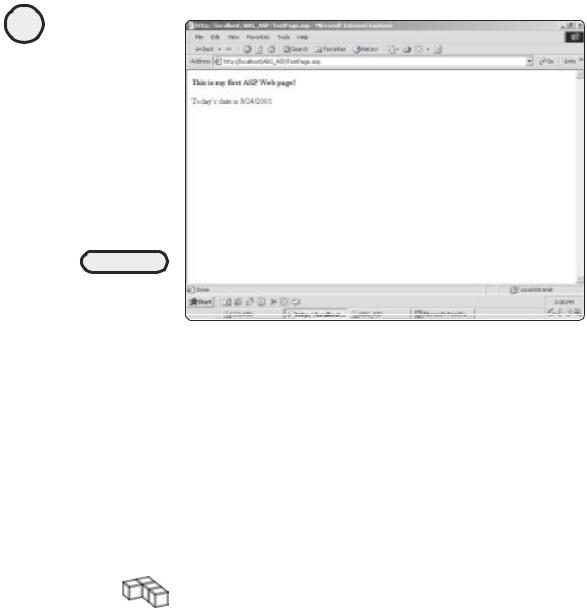
16
ASP Programming for the Absolute Beginner
FIGURE 1.17 |
|
Y |
|
|
|
||
Your first ASP |
L |
||
Web page. |
|||
F |
|||
Congratulations! |
|||
|
M |
|
|
|
A |
|
|
E consists of a few parts. To confirm that you understand how these URLs are constructed
(thus confirming that you understand how to access the Web pages you create in this book), take a moment to review the elements of the URL you entered to display your
TestPage.asp page (http://localhost/TestPage.asp or http://127.0.0.1/TestPage.asp):
•The http:// is the typical association with the hypertext transfer protocol—no surprises here.
•The next part of the URL is the name of your server running on your computer. If you are using Windows 2000 with IIS, this is the localhost section of the URL. If you are using Windows 98 and the PWS, the name of your server is the default
127.0.0.1.
TRICK |
Although it’s probably easy to remember 127.0.0.1 or localhost, you might want to |
|
|
|
bookmark this home page address of your server within your browser application |
|
so that you don’t have to retype it each time you want to access it. |
• Finally, /TestPage.asp is the name of the Web page you want to view.
Note that, as you develop different Web sites and organize your pages within the Inetpub folder, you can create subfolders underneath the wwwroot folder. For example, say that you create a Web site describing your family history. The home page of this particular Web site is History_Home.asp. The full URL for accessing this page could be
http://localhost/Family_History/History_Home.asp.
Family_History is the name of the subfolder you created to store all Web pages associated with this particular site, and History_Home.asp is one of perhaps many Web pages related to this family history Web site (see Figure 1.18).
Team-Fly®
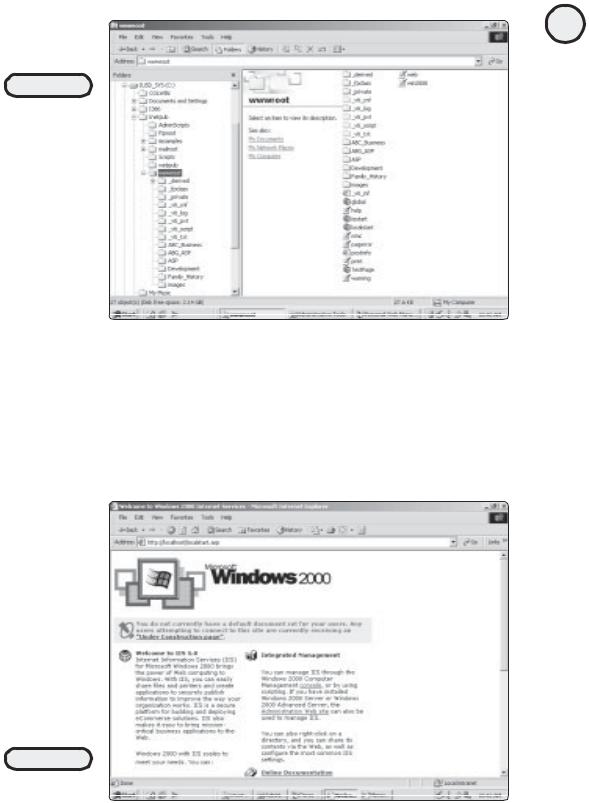
FIGURE 1.18
A typical folder hierarchy, showing different Web folders underneath the Inetpub and wwwroot folders. Under the wwwroot folder, the folders Family_History and ABC_Business are specific Web sites and contain the Web pages that make up those sites.
Displaying the Default IIS Home Page
If you are using IIS, you access the default home page of the server by opening your Web browser and entering the following URL: http://localhost/. The default home page will load, as shown in Figure 1.19.
17
C h a p te r
1
P re p a r i n g
t o
W o r k
w it h
A S P
FIGURE 1.19
The default home
page for IIS.
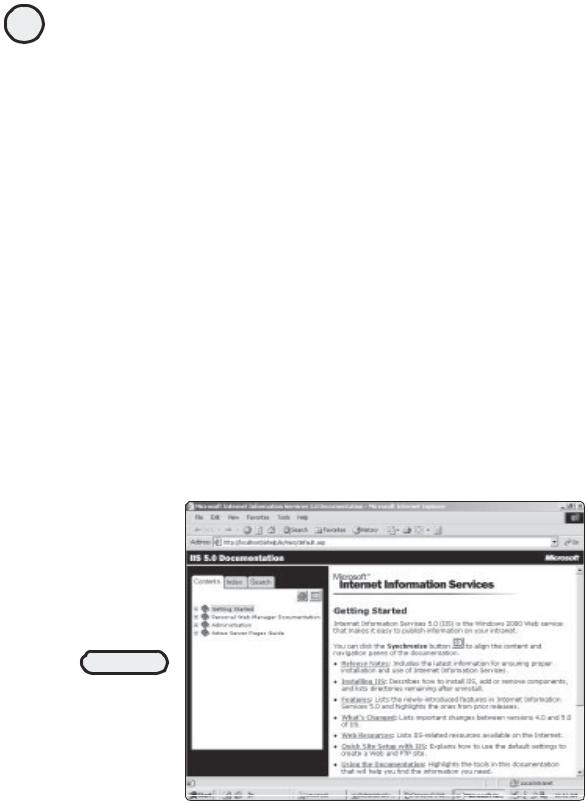
18
ASP Programming for the Absolute Beginner
As you see in Figure 1.20, you can access additional information about IIS from this page. Links to the administrative tools discussed earlier, as well as more extensive online documentation, are quickly reached from here.
Displaying the Default PWS Home Page
If you are using PWS, you can access the default server home page, including on-line documentation, just like the information available via IIS. To access the default home page of PWS, open your Web browser and enter the following URL: http://127.0.0.1/. The default home page will load, as shown in Figure 1.21.
Choosing an ASP Application
Development Tool
You’re nearly set to begin your ASP programming adventure, now that you have your developmental Web server installed and configured. However, there is one major question I haven’t yet discussed: With what tool are you going to enter all your ASP program code?
This is an excellent question, and one I’ll address in a variety of ways as you move through this book. For now, though, you should keep the following in mind:
•When learning a new programming language, it is best to do things “by hand” first, rather than rely on an application development package, Through the use of wizards, on-line help, or other “crutch” features, you circumvent gaining a real understanding of the fundamental concepts. Although useful, these crutches don’t expose you to how things work.
FIGURE 1.20
IIS comes complete
with extensive
on-line
documentation.
Note the extensive
documentation
also available
regarding ASP.
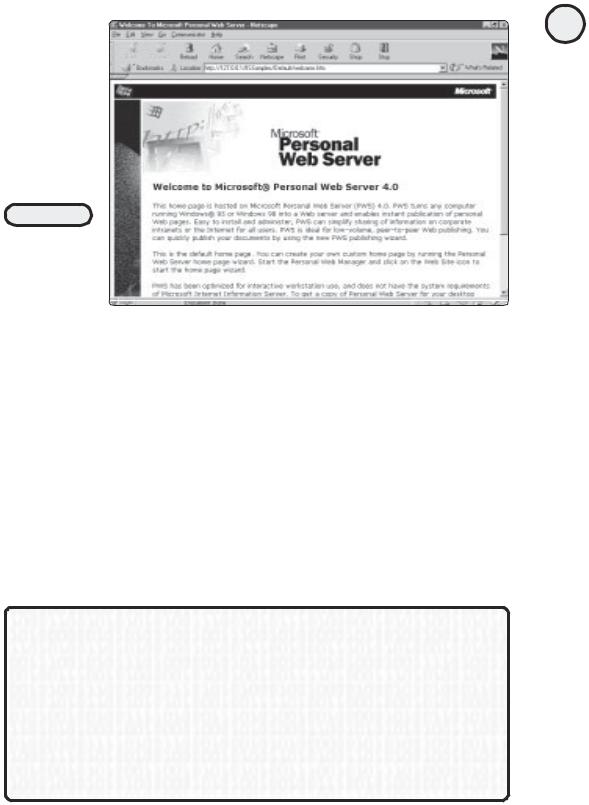
FIGURE 1.21
On-line
documentation is
also available via
the PWS default
home page.
•Application development packages oftentimes insert their own special code on top of or in addition to the code you enter. Again, although potentially useful (and taking a lot of the grunt work out of programming), this extra code can be confusing as you attempt to learn the fundamentals of the language.
•After you get a solid understanding of the fundamental concepts of the language, you can move to an application development package to enhance the skills you already have learned. Thus, you gain the benefit of working with the development package.
What does all this mean? Put simply, as you begin programming with ASP, you’re going to stick with a straight text editor (Notepad should suffice). Because you will hand-code all your programming, you will gain a much stronger understanding of ASP fundamentals.
If you take a quick look at the table of contents, you will see that I also provide detailed information on how to work with Microsoft FrontPage 2000 in conjunction with your ASP development (see Figure 1.22). FrontPage is a wonderful tool and makes
IN THE REAL WORLD
Even though ASP is a Microsoft technology, its popularity and power have caused other companies to integrate support for ASP into their products. FrontPage remains (in my humble opinion) the tool of choice for quick and easy ASP Web development, but other products are available. For example, HomeSite, manufactured by Macromedia, is another very solid Web application development tool that natively supports ASP development (see Figure 1.23). By natively supports, I mean that ASP functionality is built in.
Your choice of application development tool (if you choose to use one) is ultimately your decision. Eventually, you will want to use one because these types of applications make your development work much easier and faster.
19
C h a p te r
1
P re p a r i n g
t o
W o r k
w it h
A S P
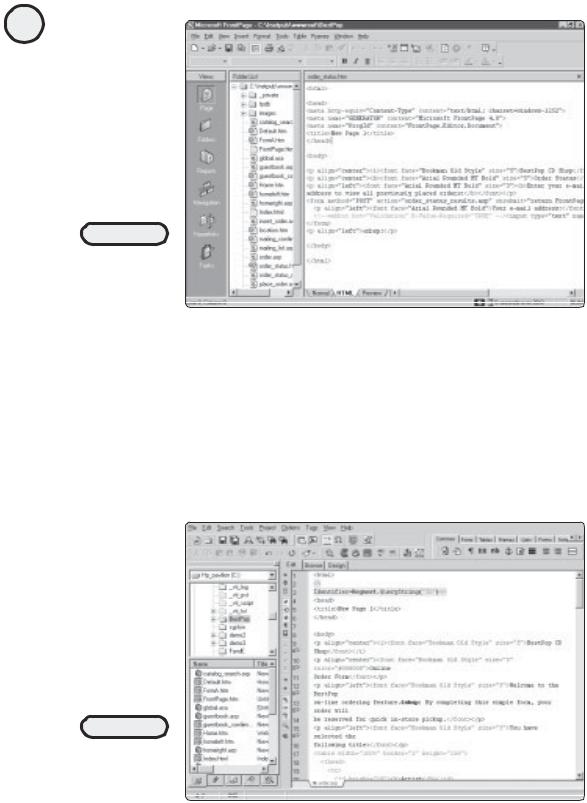
20
ASP Programming for the Absolute Beginner
FIGURE 1.22
Working with
Microsoft FrontPage
2000 as your ASP
development tool.
the development of your Web sites much easier, more productive, and more fun. Before you get to FrontPage, you will do everything by hand to ensure that you understand how all this ASP programming works. You might have to enter a few extra keystrokes (there are no Web development wizards in Notepad), but your effort will be well worth it!
Summary
In this first chapter, you learned what ASP is and how it interacts with Web servers and Web browser software. You also took a look at the Web servers you should load on your
FIGURE 1.23
Utilizing
Macromedia
HomeSite to
develop with ASP.
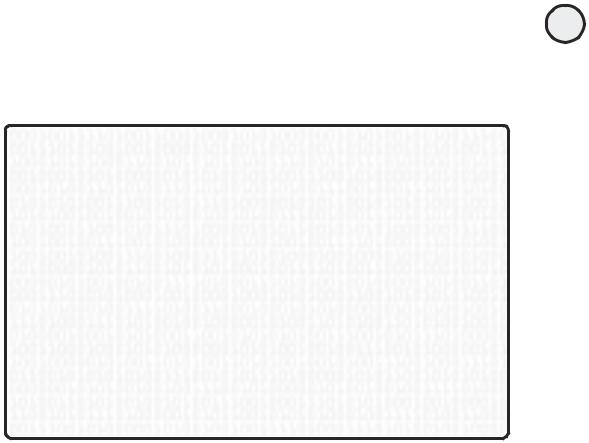
computer to work most effectively with ASP in general and with the information provided in this book. Finally, I quickly talked about the use of FrontPage 2000 and other application development tools. I stressed that it is in your best interest to hold off on using these tools until you gain a solid understanding of ASP fundamentals.
E X E R C I S E S
To ensure you have a good understanding of the Web server configuration issues presented in
this chapter, take a look at the following exercises:
1.Open Notepad, Word, and so on, and describe the advantages of working with ASP.
2.Continuing with the above, write another paragraph that describes the differences between ASP and a regular HTML Web page.
3.Create at least two new ASP Web pages so that you are comfortable with where to save them (i.e., in the Inetpub directory) and how to save them (that is, with the .asp extension).
4.Take a few moments to search the Web for more information on both Microsoft FrontPage (http://www.microsoft.com) and Macromedia HomeSite (http://www.macromedia.com). Although you may not have experience with either program, take a moment to review their features to see how they both support ASP development. Also, see if you can find information on other Web development tools that support ASP.
5.Finally, review the enclosed CD-ROM to see the goodies that have been included and to fire your imagination and interest as to the exciting things that await you in this book!
21
C h a p te r
1
P re p a r i n g
t o
W o r k
w it h
A S P
This page intentionally left blank

C2H A P T E R
Programming ASP
Web Pages with
VBScript
In this chapter, you will
•Learn how Visual Basic Script (or VBScript) is at the center of all your ASP development and how you can integrate VBScript into all your ASP programming.
•Learn the core concept of variables and why (and how) they are an essential programming component.
•Learn fundamental programming statements that bring your VBScript code to life.
•Build your first ASP game, Hello, World!, which will utilize all the concepts you learn in this chapter.
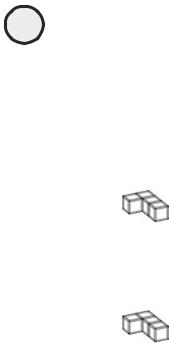
24
ASP Programming for the Absolute Beginner
Before you begin developing the whiz-bang ASP pages I know you’ve been dreaming about since you first purchased this book(!), there are some fundamental concepts of programming with which you need to become familiar. I can hear the groans now, and I know what you’re probably thinking: “Fundamental concepts! That sounds like a synonym for boring!” Although it’s true that the material you will learn in this chapter might not be as interesting as the games you will soon be developing, keep in mind the operative phrase here: soon be developing. In other words, I’ll try my hardest to get you through this perfunctory yet critical material as quickly as possible, and we’ll try to have a little fun along the way, too.
TRICK |
This chapter was written to give you a general overview of VBScript, to get your |
|
|
|
programmer’s feet wet, and, I hope, get you excited about the wonderful things you |
|
can learn and do by reading the rest of this book. As you read sections that particu- |
|
larly interest you, be sure to note the additional reference chapters, which go into |
|
far more detail, including lots of coding examples, on the subject being discussed. |
TRICK |
All the code examples in this chapter can be found on the enclosed CD-ROM. If you |
|
|
|
want to follow along and test the examples, you can open them with Notepad or any |
|
other text editor at your disposal and save them in the Inetpub folder on your hard |
|
drive. If you don’t know what the Inetpub folder is, take another look at Chapter 1, |
|
“Preparing to Work with ASP.” You might create a separate folder in the Inetpub |
|
folder and call it ABG_ASP. In this folder, you can place all the code examples you |
|
work through in this book, which will help you keep everything organized. |
Integrating VBScript with ASP
This discussion of VBScript begins with a quick demonstration. Figure 2.1 shows a simple Web page with a typical .html extension.
Take a closer look at this page:
•Notice the name of the page: ABC.html. As you know, HTML is short for Hypertext Markup Language, the primary method of posting information on the Web.
•Note the following text: Upon receipt of your letter of inquiry, you should receive information about the company in 4-6 weeks. The ABC Company is fictitious, of course, but four-to-six weeks, in my opinion, is a long time to wait for information, especially if you have to go to the trouble of mailing an inquiry.
•Take a look at the HTML code that constructed this page:
Listing 2.1 ABC.html
<html>
<head>
<title>Welcome to the ABC Company</title>
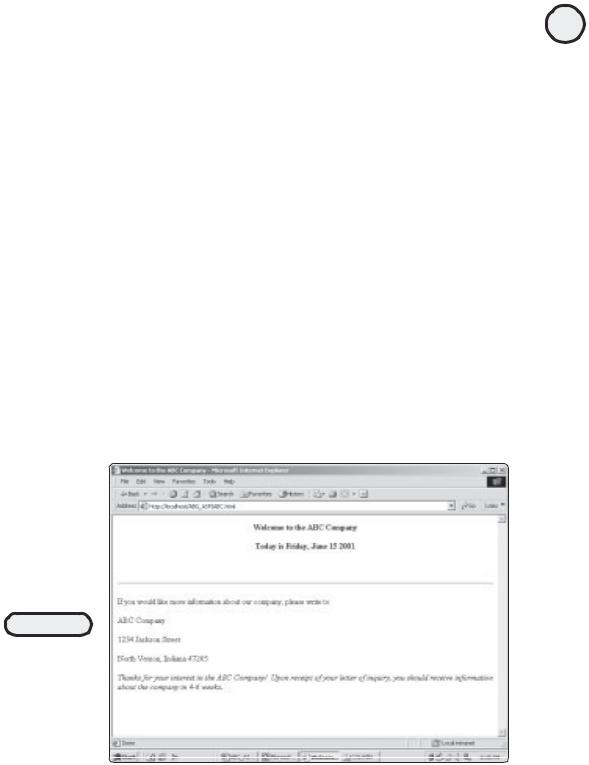
</head>
<body>
<p align="center"><b>Welcome to the ABC Company </b></p> <p align="center"><b>Today is Friday, June 15 2001</b></p> <hr>
<p align="left">If you would like more information about our company, please write to:</p>
<p align="left">ABC Company</p>
<p align="left">1234 Jackson Street</p>
<p align="left">North Vernon, Indiana 47265</p>
<p align="left"><i>Thanks for your interest in the ABC Company! Upon receipt of your letter of inquiry, you should receive information about the company in 4-6 weeks.</i></p>
</body>
</html>
Notice that the date (in this case, June 15, 2001) is hard-coded into the HTML. This means that for the page to remain accurate, the HTML has to be manually updated (that is, changed) each day to reflect the change in the date.
Now, consider the same page as an ASP page, illustrated in Figure 2.2. Note the .asp extension in place of the usual .html.
FIGURE 2.1
A simple Web page describing the fictitious ABC Company. Note the
.html extension in the name of this Web page,
ABC.html.
25
C h a p te r
2
P r o g r am m i n A g S P
W e P b a g e s
w i t h
V B S c ri p t
